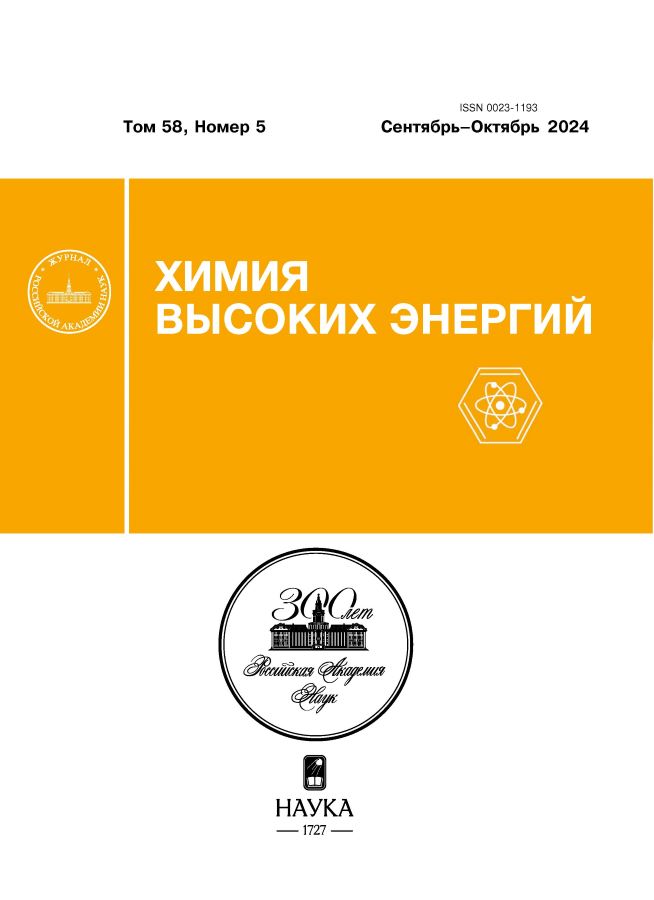Fourier transform IR spectroscopic study of gamma-irradiated papain
- Авторлар: Allayarov S.R.1, Rudneva T.N.2, Demidov S.V.1, Allayarova U.Y.1, Chekalina S.D.1
-
Мекемелер:
- Federal Research Center for Problems of Chemical Physics and Medicinal Chemistry, Russian Academy of Sciences
- Institute of microelectronics technology and high purity materials, Russian Academy of Sciences
- Шығарылым: Том 58, № 5 (2024)
- Беттер: 397-403
- Бөлім: RADIATION CHEMISTRY
- URL: https://ter-arkhiv.ru/0023-1193/article/view/684847
- DOI: https://doi.org/10.31857/S0023119324050087
- EDN: https://elibrary.ru/TXPYMC
- ID: 684847
Дәйексөз келтіру
Аннотация
In papain macromolecules irradiated with γ-rays, fragments with terminal primary amino groups are formed, which appear in FTIR spectra as a broad peak with a maximum at 3440 cm–1, as well as an intense absorption band centred at 1706 cm–1 as a result of valence vibrations of carbonyl groups. The intensity of the absorption bands of the radiolysis products increases linearly with the irradiation dose of papain. At the same time, with increasing irradiation dose, a marked weakening of the intensity of the maxima of the absorption peaks of the peptide bond is observed, which indicates radiation destruction of the main chain of papain.
Негізгі сөздер
Толық мәтін
Авторлар туралы
S. Allayarov
Federal Research Center for Problems of Chemical Physics and Medicinal Chemistry, Russian Academy of Sciences
Хат алмасуға жауапты Автор.
Email: sadush@icp.ac.ru
Ресей, Chernogolovka
T. Rudneva
Institute of microelectronics technology and high purity materials, Russian Academy of Sciences
Email: sadush@icp.ac.ru
Ресей, Chernogolovka
S. Demidov
Federal Research Center for Problems of Chemical Physics and Medicinal Chemistry, Russian Academy of Sciences
Email: sadush@icp.ac.ru
Ресей, Chernogolovka
U. Allayarova
Federal Research Center for Problems of Chemical Physics and Medicinal Chemistry, Russian Academy of Sciences
Email: sadush@icp.ac.ru
Ресей, Chernogolovka
S. Chekalina
Federal Research Center for Problems of Chemical Physics and Medicinal Chemistry, Russian Academy of Sciences
Email: sadush@icp.ac.ru
Ресей, Chernogolovka
Әдебиет тізімі
- Varca G.H.C., Kadlubowski S., Wolszczak M., Lugão A.B., Rosiak J.M., Ulanski P. // J. Biolog. Macromol.2016. V. 92. P. 654.
- Varca G.H.C., Ferraz C.C.F., Lopes P.S., Mathor M.B., Grasselli M., Lugão A.B. // Rad. Phys. Chem.2014. V. 94. P. 181.
- Pearson J.F., Slifkin M.A. // Spectrochim. Acta. 1972. V. 28A. P. 2403.
- Carey P. Biochemical applications of Raman and resonance Raman spectroscopies. M.: Mir, 1985. 272 p.
- Wolpert M., Hellwig P. // Spectrochim. Acta. 2006. V. 64A. P. 987.
- Pei Y., Wang J., Wu K., Xuan X., Lu X. // Separ. Purific. Technol. 2009. V. 64. № 3. P. 288.
- Socrates G. Infrared and Raman Characteristic Group Frequencies Tables and Charts Third Edition. NY: John Wiley & Sons, Inc., 2004.
- Bai Z., Chao Y., Zhang M., Han C., Zhu W., Chang Y. et al. // J. Chem. 2013. V. 2013. Article 938154.
- Samsonova L.G. Application of IR and PMR spectroscopy in the study of the structure of organic molecules Textbook. 2016. Tomsk: Publishing House of Tomsk State University, 60 p.
- Tarasevich B.N. IK spektry osnovnykh klassov organicheskikh soedinenii. Spravochnye materialy (IR Spectra of Main Classes of Organic Compounds: Reference Materials), M.: Khimicheskii Fakul’tet MGU, 2012.
- Kanbargi K.D., Sonawane S.K., Arya S.S. // Int. J. Food Prop. 2017. V. 20. № 12. P. 3215.
- Timofeev-Resovsky N.V., Savich A.V., Shalnov M.I. Introduction to Molecular Radiobiology: Physical and Chemical Basis. M.: Medicine, 1981. 319 p.
- Koenig L.L. // Uspekhi Chemii. 1975. V. XLIV. Iss. 6. P. 1109.
- Szymanska-Chargot M., Zdunek A. // Food Biophysics. 2013. V. 8. P. 29.
- Kuptsov А.Kh., Zhizhin G.N. FT-Raman and FT-IR spectra of polymers. M.: Fizmatlit, 2001. 657 p.
- Sedakova V.A., Gromova E.S. // Bulletin of Pharmacy. 2011. № 4. P. 17.
Қосымша файлдар












